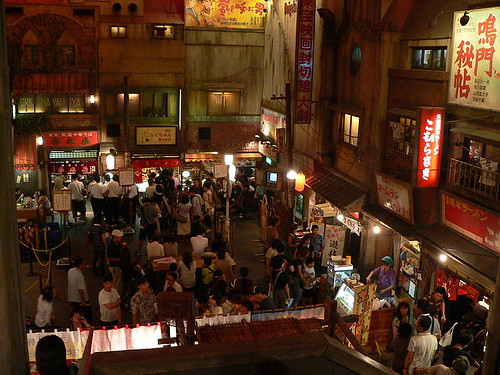The Real Ramen
Just about anyone who went to college in the United States after about 1990 has heard of Ramen noodles. Some Americans pronounce this word as “Ray-man” noodles. I’m ok with that as long as you are referring to Maru-chan or the millions of other varieties of freeze dried noodles that we bought for 10 cents a pack back in the day. There are many ways to make these cardboard tasting noodles taste better. My personal favorite was lots of salsa and corn mixed into the “Oriental” flavor. If you are feeling nostalgic, check out the Instant Ramen Museum in Osaka (http://www.nissin-noodles.com/english.htm)

Now that you and I are both out of college, let me introduce you to ramen for grown-ups. Ramen is actually pronounced “rah-men” and originally came from China. Today you can still find many amazing bowls of noodles throughout Asia. I highly recommend Pho from Vietnam and Nhung Mien from Korea. However, if you are going to have REAL ramen, go to Japan.
There are many varieties of Ramen in Japan today. The main varieties are Soy (shoyu), Salt (shio), Miso, and Pork bone (tonkotsu). Each of the regions of Japan has further subdivided up these categories to incorporate local flavors, flora and fauna. Hokkaido has some of the biggest farms and dairies in Japan, and therefore their ramen usually has milk, butter, and corn in it. North-central Japan has been a center for miso production for centuries, hence there are myriad varieties of miso ramen. By far the best version of miso ramen in my opinion comes from Fukushima and Yamagata Prefecture and is called Kara-Miso Ramen. It’s a spicy miso mixed with garlic, red chilies and many, many other spices. If you have a cold, I guarantee one bowl of this ramen will cure you!

The best ramen in all of Japan, in my completely unbiased (wink wink) opinion is Tonkotsu ramen. This is a specialty of northern Kyushu. Tonkotsu literally means pork bone, and this type of soup is so named because the stock is made from the bone of the pig. Accomplished ramen chefs start with stock pots as large as five feet tall to boil down the bone, and sometimes almost the whole pig! The downside is that oftentimes the production of the stock results in a very pungent odor. In fact, this scent is so strong, it usually helps me find a good tonkotsu ramen place from a block or two away.
Tonkotsu is the thickest of the typical ramen soup bases. It usually contains copious amounts of garlic, ginger, and sesame, on top of the natural fats that come from the pork bone stock. Most Tonkotsu establishments allow you to request the thickness of the soup, amount of garlic, level of spiciness, and degree of fat. My recommendation is to say heavy on everything; but if it is your first time, go for regular and you won’t be disappointed. Wonderful extras that most high quality establishments offer include kimchi (Spicy Korean pickled cabbage), gyoza (pot stickers), and of course chashu (slices of pork). If you are concerned about your cholesterol level this soup is not for you. However, if you are like me, trying to find the spice of life; look no further!
The three best varieties of Tonkotsu ramen are Kurume, Hakata, and Kumamoto ramen. These are three areas of northern Kyushu that have developed their own slightly distinct varieties based on different types of noodles and broth ingredients. If you have the time, I highly recommend traveling around the country in search of a great bowl. Some Hakata-style ramen can be found in Tokyo but the best shops are in the city of Fukuoka. A true noodle-head will be up for the few hour train ride from Tokyo for the original treat. Kurume and Kumamato are both south of Fukuoka and slightly off the beaten path; but if you have the chance, take the time and Carpe Noodle!

The keys to finding great ramen shop are simple:
1) Long lines at lunch time. Japanese people know their noodles; if there is a queue, get in it!
2) Dark, smelly, and sketchy-looking places are usually the sign of good bowl of ramen. It means the place has been around a while and the chef is focused on the broth, so they haven’t had to worry about making the place fancy.
3) Look for family-owned places. Usually these have been around for decades, have lots of great ambiance, are smaller, and much tastier than the big chain restaurants.

A quick note on etiquette for eating ramen: SLURP. The Japanese for this is “otto wo tateru,” literally, “make a sound.” Beyond the pure enjoyment of slurping noodles without your mom yelling at you, slurping serves the purpose of cooling down the piping hot noodles. Also, ramen is not made to be enjoyed slowly. Most ramen aficionados will slurp through their bowl in less than 10 minutes, and I’ve seen businessmen on a lunch break guzzle down a bowl of ramen in less than two minutes. There are many ramen establishments, especially in Tokyo, that do not even have chairs because the customers are expected to eat their ramen and go that quickly. If you don’t have your black belt in eating noodles with chopsticks, I recommend leaving places without chairs to the professionals.
The great news is that you don’t have to make a pilgrimage all over Japan, or have your black belt in noodle eating to try the many varieties of Ramen that exist. A 40 minute train ride from central Tokyo is the city of Yokohama. A few minute walk from Shin-Yokohama station, you will find the Mecca of ramen lovers, the Ramen Museum (http://www.raumen.co.jp/ramen/) This “food amusement park” is a bit cheesy,but located inside are at least 6 ramen shops from all over Japan offering up full size or sample size bowls of their special noodles. It seems like a tourist trap, and maybe it is, but many locals come here for lunch. To avoid the crowds and long lines, I recommend going on weekdays before or after lunch hour. Be hungry and be ready to spend several hours there; it’s worth it!

Photos:
The Noodle Shop, Narita, Japan. Narita is full of flight crews and this is a favorite place. Photo Wikimedia Commons: Larry Miller, adapted by Wandering Educators
Hakata Ramen Shop. Photo Wikimedia Commons: cathykid
Tokyo Ramen stand. Photo Wikimedia Commons: Laurent Neyssensa
Ramen stands in the simulated Showa-era Japanese town in the Shin-Yokohama Raumen Museum in Shin-Yokohama, Japan. Photo Wikimedia Commons: Calton




















Dr. Jessie Voigts
josh - you've got it. i LOVE ramen. but not this instant kind, but the real, filling, exquisite ramen in the little shops in japan. WHAT an ode to ramen!
Jessie Voigts, PhD
Publisher, wanderingeducators.com